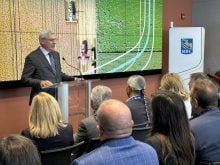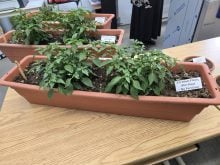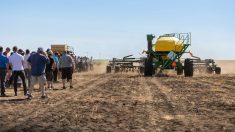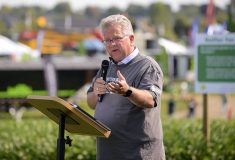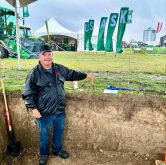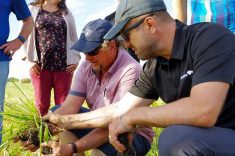Local lore has it that one of the reasons Bill Turner devoted more than two decades of his life to seemingly mundane tasks such as capping off abandoned wells dates back to his childhood.
As a nine-year-old, Turner was peering down an old well shaft when a mischievous older schoolboy gave him a little nudge from behind, causing the terrified lad to fall headfirst into the cavity – only to be caught by the ankles before he dropped out of sight.
“He called (filling in old wells) therapy; he needed to do that,” said Pembina Valley Conservation District chairman Cliff Greenfield as he related the anecdote at a special evening in honouring Turner and his assistant Dale Robinson for their work with the Deerwood Soil and Water Management Association.
Read Also

Manitoba to boost rural medical responders
Manitoba bursary aims for more accessible emergency medical responder training, better rural emergency health care.
Turner confirms the story. But although he tackled the job with gusto, sometimes capping three to four in a week, it wasn’t one of his favourite tasks. “Every time I did one, I’d wake up the night after in a cold sweat,” he says. “I finally said I couldn’t do it anymore.”
Nevertheless, Turner was honoured Jan. 26 for the enthusiasm and creativity he brought to his job as the head technician for the Deerwood association, whether it was capping those wells, building small dams, measuring rainfall events, figuring out how to collect a representative sample from a frozen manure pack, or talking to schoolkids.
INTEGRAL TEAM MEMBER
Over the past quarter-century, Turner helped the 150 farmer members experiment with new ways of managing soil and water on the Prairie landscape. Hired a year after the association first formed, the ex farmer quickly became an integral part of its evolution from a bunch of farmers with a few good ideas, to a nationally recognized research partner for governments and researchers trying to make agriculture more sustainable.
Turner was joined five years ago by assistant Dale Robinson, a retired school teacher, who was equally willing to roll up his sleeves, or stand his ground anchoring university students rappelling down a gully to take soil samples – whatever needed to be done in a typical day on the watershed.
Robinson once pulled into a farmer co-operator Gordon Orchard’s yard during calving season to find him fighting a losing battle to assist a heifer through a breech birth. He pitched right in, helping save the heifer and the calf, calling it “all in a day’s work,” Orchard told the audience.
It’s notable that the pair’s retirement dinner attracted government and university research and extension workers, some of whom travelled from afar, out of respect for the contributions of some good, old-fashioned hired hands.
At the start, the Deerwood association was all about keeping the soil on the land and preventing run-off water from tearing up the landscape. The original members wanted to construct small dams on the Pembina escarpment to slow run-off to reduce flash flooding downstream, while providing the opportunity for backflooding of forage lands.
DUCK POND LOGIC
Some engineers poohpoohed the idea saying “those little duck ponds” wouldn’t do a thing. But research proved the farmers’ hunch was right. Today, 30 per cent of the 979-square-km watershed is controlled by 26 small dams.
In its early days, the association was also involved with demonstrating and assisting farmers with implementing field shelterbelts, buffer zones around riparian areas, off-site watering systems, turning marginal land back to forage, rotational grazing, residue management, zero tillage and installing grassways through cropland to reduce soil erosion.
But it is the secondary benefit of improved soil and water management that has been gaining the most attention recently: reducing nutrient escape into waterways.
The Deerwood members have al lowed their land, water and farming practices in the South Tobacco Creek Watershed to be put under the research microscope, through the Water shed Evaluat ion of Beneficial Management Practices (WEBs) network of pilot projects set up across the country.
The region has become a living laboratory complete with records of individual land-use practices such as tillage, pesticide and fertilizer use, manure management, weather data and water quality. It’s an invaluable data set that is allowing researchers to develop and model best management practices.
FEEDBACK
It is also giving farmers feedback that allows them to reduce costs without hurting productivity.
The science has delivered some surpr ises too, noted association chair Les McEwan. While the various strategies employed were successfully keeping soil in place and reducing the nitrogen found in run-off, phosphorus levels remained perplexingly high.
Further research determined the source of that phosphorus wasn’t from soil particles, as was commonly believed, it was dissolved phosphorus that had leached from decaying plant material during spring thaw.
It was an important finding. When it comes to phosphorus management, implementing zero tillage and riparian zones may not be an effective strategy.
None of this would have been possible without reliable staff on the ground capable of executing the plan, assisting the researchers, and at times going to extraordinary lengths to ensure the integrity and consistency of the data collected.
Turner says knowing the people and understanding the land helped. “I was a local guy able to work with farmers and their land use,” he said.
Turner, who is a bit of a science buff, said he particularly enjoyed working with researchers and university students as they got their first hands-on field experience working on watershed projects.
“I wouldn’t trade the past 24 years for anything,” he says. “I was proud to be part of it.”
His one disappointment is the realization that as far as they’ve come in understanding how to live and work within a landscape, rather than on top of it, they have much further to go.
“I get frustrated,” he admits. He is convinced a wholesale shift in our culture’s “winner-take- all” mentality is needed before farming can be a sustainable part of the landscape. “Something has to change.” [email protected]



